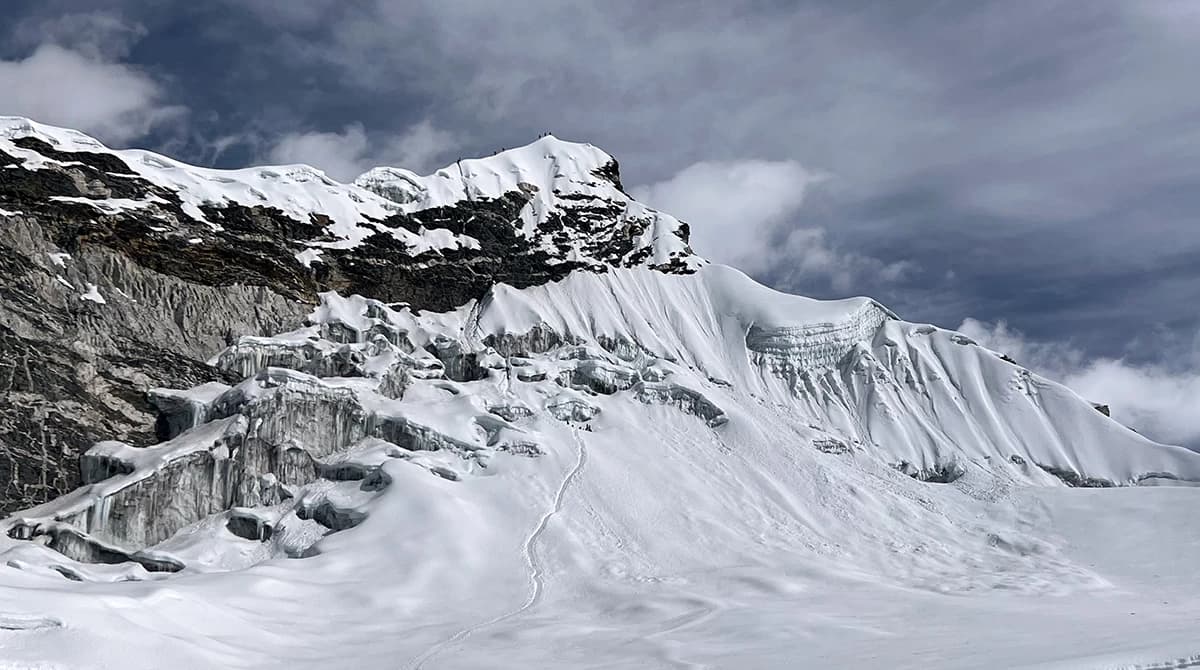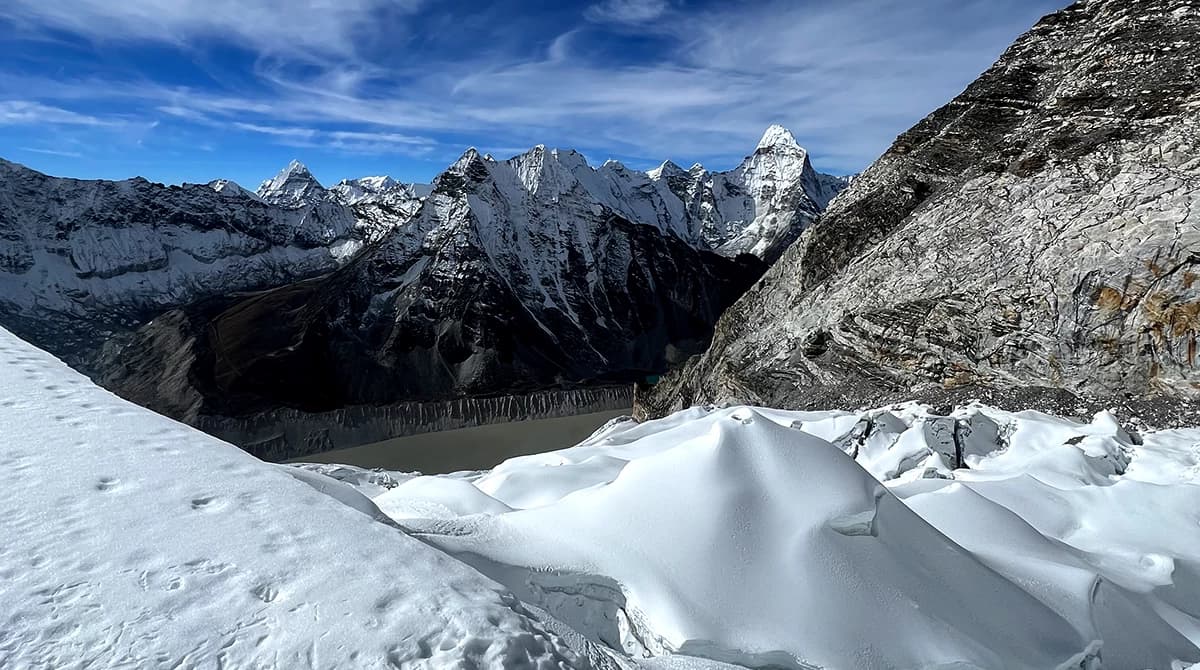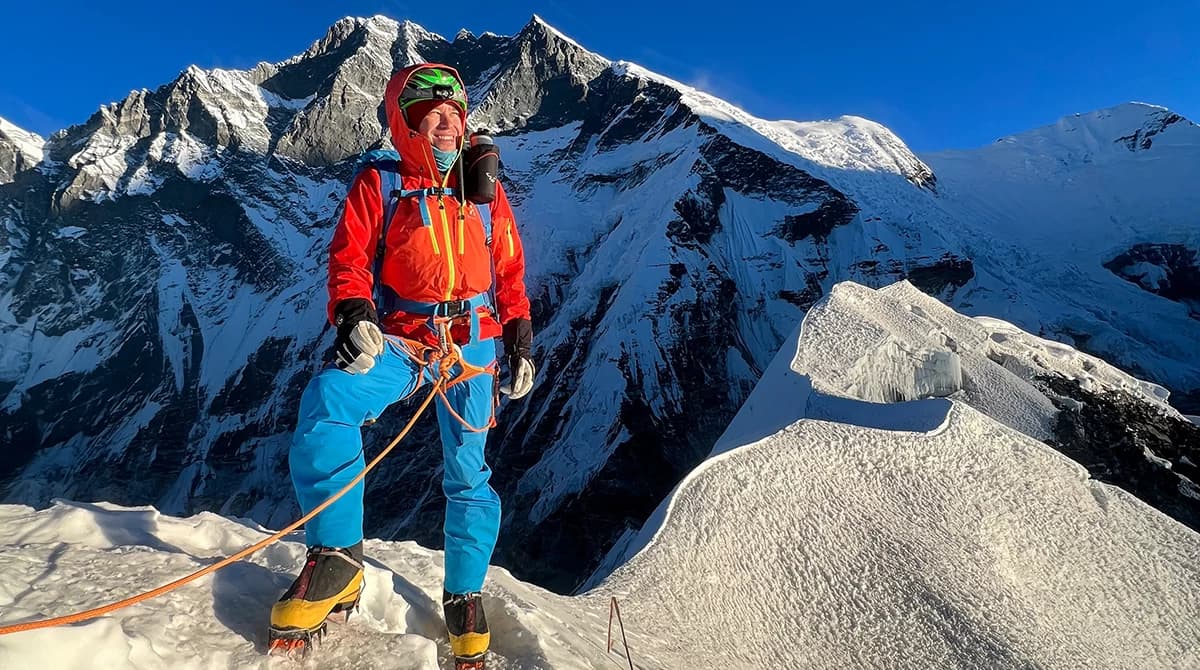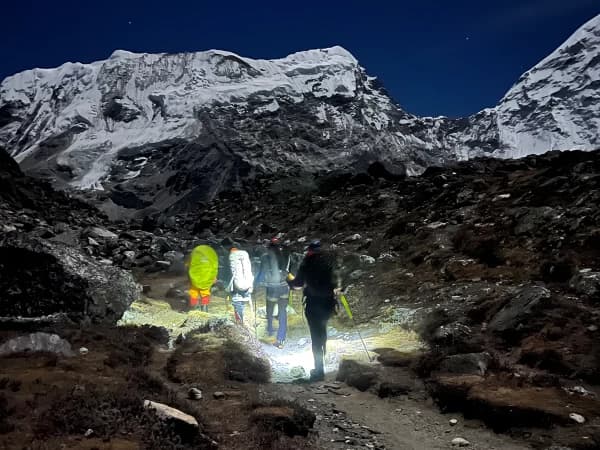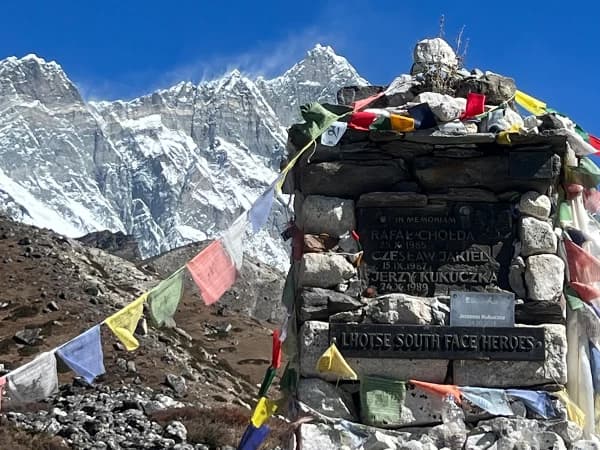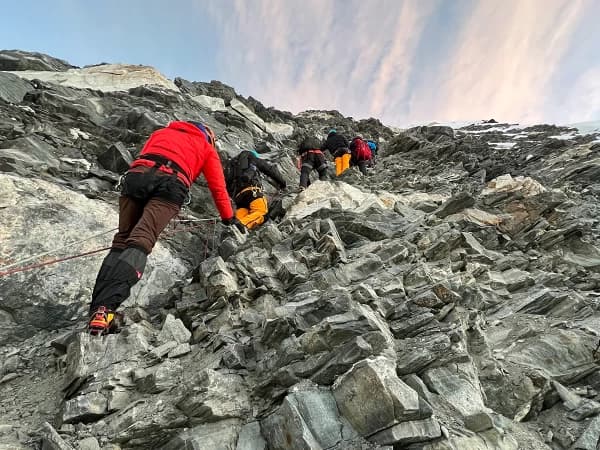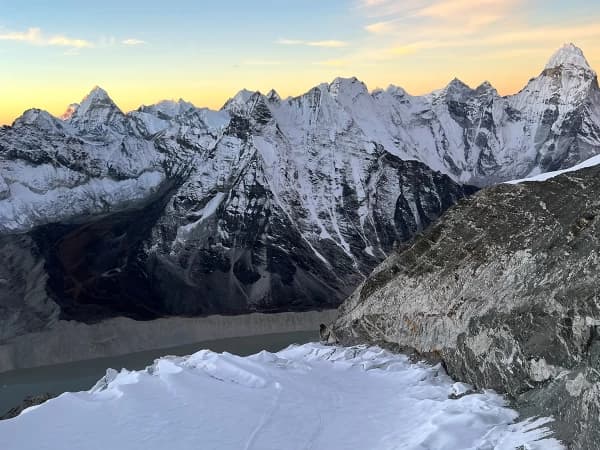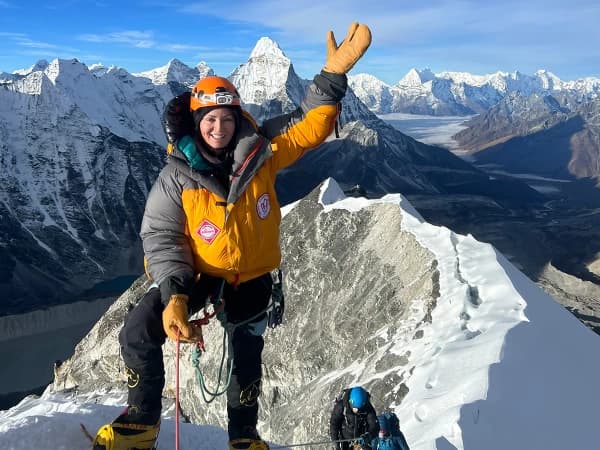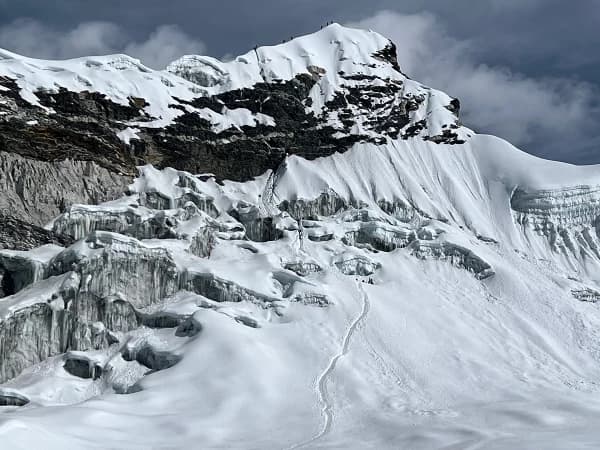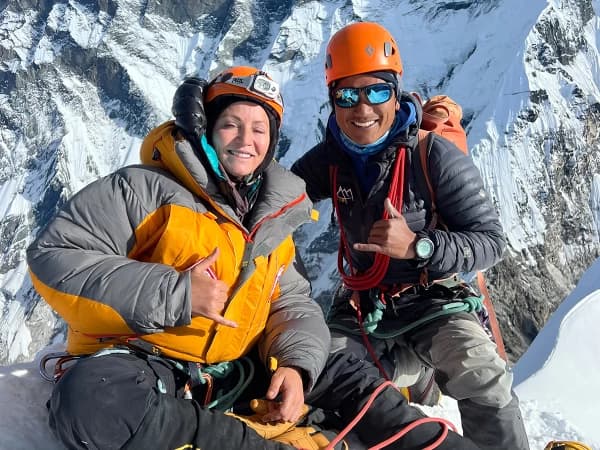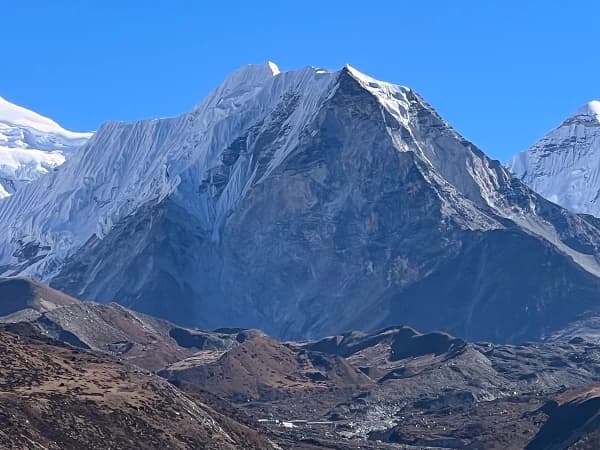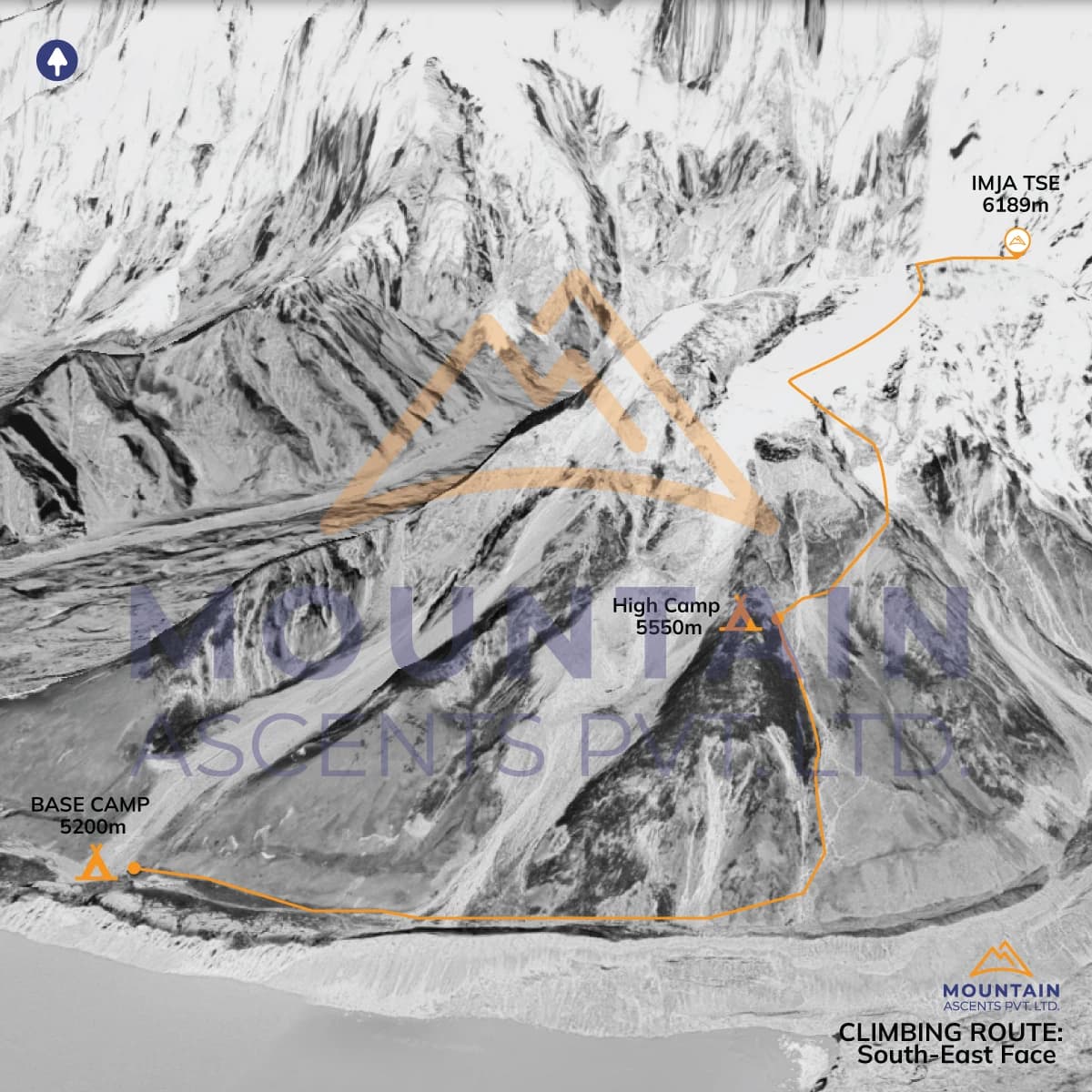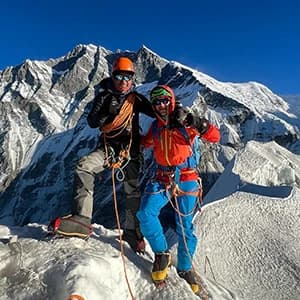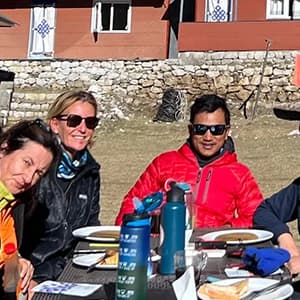The Island Peak Climbing with EBC is one of the best combo packages for trekking and climbing in the Khumbu area of Nepal for those interested in grabbing the beauty of both the famous Everest Base Camp and the thrill and adventure of climbing to Island Peak (6,165 m). Locally named Imja Tse in the early 1980s, the mountain range is widely known as “Island Peak” for appearing like an island rising from a sea of ice since 1952 A.D.
Lying in the middle of the Chhukung Valley, the journey to the Island Peak, one of the most popular trekking peaks in Nepal, combined with Everest Base Camp typically begins with a short and scenic flight to Lukla, also known as the common gateway to the Everest Trekking Region. Then, the trek follows the classic Himalayan route to the Everest Base Camp once traversed by the legends themselves, Sir Edmund Hillary and Tenzing Norgay Sherpa, along the Dudh Koshi River in the Khumbu region of Nepal.
For several days you will make your way through the traditional Himalayan settlements, mostly dominated by Sherpa ethnic communities guided by Tibetan Buddhism, such as Lukla, Phakding, Namche Bazaar, Tengboche, Pheriche, Lobuche, and others. These villages basically include facilities like tea houses and local guest houses that cater to your basic needs of meals and accommodation, some of which also serve as spiritual hubs that offer a chance to seek mental balance and relief.
Throughout this Himalayan voyage, you will be blessed with the grand mythical views of numerous snowcapped peaks such as Lhotse, Nuptse, Ama Dablam, Makalu, Pumori, Cho Oyu, Baruntse, Thamserku, Kongde Ri, and Mt. Everest (8,848), the top of the world itself, from several iconic destinations, including Everest Base Camp, Kala Patthar, Island Base Camp, and the Island Peak catering to the interests of both experienced and novice adventurers across the globe.
Yes, now you can do both the Everest Base Camp Trek and Island Peak expedition in a single trip, offering never-before-before adventure featuring visits to pristine Sherpa hamlets, tranquil monasteries, and the chance to relish unique culture, customs, traditions, and local food as you make it to the lap of Mount Everest and scale the Island Peak. Join us now for a journey of a lifetime offering a sublime mix of trekking through the infamous Khumbu Valley and a technical climb to the summit of Island Peak!
Trip Highlights
- Visit UNESCO World Heritage Sites in the Kathmandu Valley in your spare time.
- Enjoy the infamous scenically enriching adventurous flight to and from Lukla.
- Leave your footprint at the classic Everest Base Camp Himalayan route.
- Gain an intimate insight into the Sherpa culture in the Himalayas by walking along the prayer wheels, vibrant prayer flags, and suspension bridges, and visiting several religious monuments such as the Tengboche monastery and others.
- Discover the serene mountain valleys, slopes, cascading waterfalls, and dense woods of rhododendron, oak, pine, juniper, and more.
- An opportunity to catch sight of rare Himalayan species including musk deer, snow leopard, pheasants, and Himalayan Thar.
- Seize the best views of Mount Everest along the Khumbu glacier from Kala Patthar, Everest Base Camp, and Island Peak.
- Mark your victory at a 6000+ m peak in the Everest/Khumbu Trekking region.
- Marvel at the alluring beauty of Himalayan giants such as Nuptse, Lhotse, Lhotse Middle, Lhotse Shar, Makalu, Baruntse, and Ama Dablam, all predominated by the tallest mountain in the world, Mt. Everest (8,848 m), etc.
What to expect during the Trek to EBC and Island Peak Climbing?
As it is understood, the Island Peak Climbing with EBC is one of the combined trekking and climbing packages in the Everest region where, during the trekking phase, one has to walk at least 5-7 hours a day during the trekking days, and on the climbing phase, one starts from the time you reach the Island Peak Base Camp to the peak of this island.
Similarly, though the primary goal of this fused Himalayan voyage is trekking to EBC and climbing Island Peak, you will not miss any of the cultural, natural, and other highlights of the region, including the Sherpa lifestyle, ancient monasteries, and wide array of flora and fauna of the Sagarmatha National Park, blending so well with high-altitude trekking and climbing. Here’s what makes this journey a special intake:
Trekking through varied terrain
The EBC Expedition's journey to Island Peak begins with a scenic Everest flight to Lukla from Kathmandu, followed by trekking to one of the world's most renowned treks, the Everest Base Camp, through Nepal's beautiful, culturally and naturally abundant Khumbu Valley, which is part of the Sagarmatha National Park, a natural UNESCO World Heritage Site.
Known for the resilience and culture of Sherpa people, Buddhist monasteries, and some of the world’s most iconic mountain views, the trekking terrain venturing to Everest Base Camp and Island Peak varies from dense, lush forests at lower altitudes to rugged paths, alpine meadows, and glacial moraines as you move forth to the higher altitude areas.
The experience is indescribable in words as you observe the constant change in scenery while the environment gets more exciting with new visual rewards in every turn you take, meandering along green forests and rivers of the lower Khumbu region to barren, high-altitude lakes and meadows near Everest Base Camp, Kala Patthar, and finally the ice-like icy and glaciated surroundings of Island Peak.
Adventurous Climbing to Island Peak
After the classic trek to the Everest Base Camp (EBC), the Himalayan climbing shifts into mountaineering mode that at first begins with a trek to Chhukung and then Island Base Camp, and eventually to Island Peak. Standing tall at an elevation of 6,165m/50,305 above sea level, nestled near popular Mount Everest, Island Peak, also called Imja Tse, is just a fantastic practice peak for climbers who want to test their skills before officially heading for higher altitude peaks above 7,000m or 8,000m.
Overall, the climb is taken as moderately challenging and also involves some technical setbacks of having to cross glaciers, use ropes and crampons, and a high-altitude hike towards the Himalayan peak at a low oxygen level. The climb through crevasses, ice fields, and glacial mountains is more adventurous, however, suitable for even beginners without the extreme difficulty of higher peaks such as Mt. Everest, Manaslu, and others capable of possessing some basic mountaineering skills.
Nonetheless, if you begin early in the morning when the weather is relatively more favorable than in the afternoon, the summit offers otherworldly panoramic views of the surrounding mountains, including Lhotse, Makalu, Baruntse, Ama Dablam, and others, promising an unmeasurable sense of achievement, especially best done during spring (March-May) or autumn (September-November).
World-class Himalayan views
Throughout the Everest Base Camp Trek and Island Peak climb, you will be in the presence of some of the world’s most iconic Himalayan ranges, usually covered in snow, including Everest, Lhotse, Nuptse, and Pumori. As you begin the leg work from Lukla, the trekking route is through the Dudh Koshi River with the very first sight of Kusum Kanguru and Thamserku. The view gets more expensive as you move towards Namche Bazaar, the trade and cultural hub of the Everest region, also serving as the main gateway to Mount Everest, offering majestic views of Everest and Ama Dablam in the distance.
As the trek progresses, the trail from Namche to Tengboche is predominated by the stunning views of Ama Dablam and more refined Himalayan views of Everest and Lhotse, while the Everest Base Camp and Kala Patthar are framed by sky-towering Himalayan giants, including the South Face of Everest, Pumori, Nuptse, and Lingtren. However, as you ascend to Island Peak Base Camp and later on the summit, you will be offered a never-before-seen 360-degree panorama of Lhotse, Makalu, Baruntse, and pyramid-like Ama Dablam, surrounded by glaciers, ridges, and several peaks to capture in photographs, especially during sunset and sunrise. A photographer’s dream, for sure!
Rich Sherpa's Cultural Experience
While doing the trekking phase in Island Peak Climbing via Everest Base Camp (EBC), you get to walk past many Sherpa-culture villages like Phadking, Namche Bazaar, Tengboche, Dingboche, Lobuche, Chhukung, etc., most places with welcoming uphill teahouses offering home-cooked meals and simple soups, rice dishes such as Dal Bhat, momos, and Thukpa.
Therefore, along the route, you will get to experience Sherpa culture firsthand as you pave your way through the heart of Sherpa country and get a closer insight into their unique way of life, religious traditions, and true culture, most likely influenced by Tibetan Buddhism that has been passed down from generations to generations.
Sherpas are among the unique Indigenous communities, locals to the Himalayas of Nepal, popular worldwide for their extraordinary mountaineering skills and adaptation to the arduous mountainous surroundings with comparatively thin air, an integral element for most successful ascents to the majestic snow-capped peaks.
They cherish their cultural and religious heritages, where the visit to several sacred monasteries, spinning prayer wheels, mani walls, and prayer flags adds much to the spiritual dimensions of the trip to the Island Peak Climbing with the EBC (Everest Base Camp), as you also get to relish the authentic Sherpa hospitality in local tea houses and lodges that also provides you with a golden chance to connect with locals of the Himalayas and fellow trekking and climbing aspirants.
Adventure for all skill levels
There is no doubt that the Island Peak with Everest Base Camp (EBC) expedition combines the high altitude trekking with the physical demands of climbing and tests one's level of endurance, strength, and mental determination, which in fact makes it more than a physical testament, giving you a life-changing experience and fostering a deep sense of personal accomplishment. It is actually beginner-friendly.
On being accompanied by a professional mountain guide authorized by the government of Nepal itself, the success rate is high as they also help you learn basic skills like using crampons, ropes, and ice axes, along with packing, navigation of challenging sections, and managing all trekking and climbing logistics, including food, accommodation, and necessary permits.
Serving as the stepping stone for more challenging climbs in the future, the expedition also provides flexibility, so those who find Island Peak summit challenging, can enjoy the journey to Everest Base Camp to the fullest, exploring all the major highlights of the Everest/Khumbu region to the fullest, and offering a comprehensive experience for groups with varied fitness, experience, and preference levels.
Why the 20-day itinerary is the best route for Island Peak Climbing with the EBC?
The 20-day itinerary Island Peak Climbing with Everest Base Camp Trekking begins as soon as you land at the Tribhuvan International Airport (TIA) in Nepal, Kathmandu. Thereafter one whole day is allocated for trip preparation to unwind in the Kathmandu Valley, the capital city filled with at least seven of the culturally, historically, and religiously significant UNESCO World Heritage Sites.
On the third day, you will finally fly over to Lukla. The flight is daring as you get to enjoy the magnificent aerial views of the green valleys, traditional villages, hills, and snow-capped Himalayas, finally landing at the height of 2,846 m in the Lukla airport, initiating the hike that goes through Phakding, Namche, Tengboche, Pheriche, Lobuche, Gorak Shep, and finally the Everest Base Camp.
However, the journey does not end there; it continues towards Kala Patthar, descending to Lobuche for the night and the next day, Chhukung. Taking much-needed rest and nutritious breakfast in Chhukung, the following morning you will head to the Island Peak Base Camp and then the Island Peak summit itself and descend towards the Island Peak Base Camp, marking the beginning of the journey to return to the Kathmandu Valley, which retraces the route back all in 20 days.
Further, this itinerary lets you maintain your pace along with ample acclimatization, one whole day in the Kathmandu Valley and an entire day in Namche Bazaar along with a contingency day so trekkers and climbers get to avoid altitude sickness and increase the chances of summit success with its flexibility for weather, rest, and full-on exploration. Or you can get your tailored itinerary best suited for you at Mountain Ascents, where it is advisable to add trek and climb days for a better and more hassle-free experience.
20-day Island Peak Climbing with EBC Cost
The Island Peak Climbing with Everest Base Camp Cost can vary based on several factors, such as the level of service, type of trek and expedition operators (locals and internationals), group size, and whether you are looking for a more budget-friendly option, luxury, or standard package.
Nonetheless, at Mountain Ascents, we offer the best value on every trek, tour, trip, and Himalayan expedition you do with us, including Island Peak Climbing with Everest Base Camp Trekking Cost that can typically range from USD 3,000 to USD 5,000 per person, which can alter on changing the mode of accommodation and other amenities.
Therefore, for better and exact pricing, feel free to contact us, where we are offering group discounted prices even for years 2025 and 2026.
